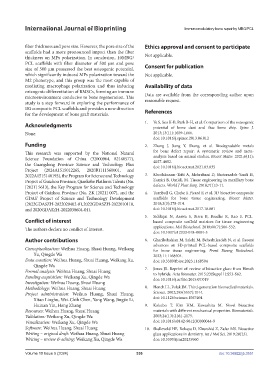Page 344 - IJB-10-5
P. 344
International Journal of Bioprinting Immunomodulatory bone repair by MBG/PCL
fiber thickness and pore size. However, the pore size of the Ethics approval and consent to participate
scaffolds had a more pronounced impact than the fiber
thickness on MPs polarization. In conclusion, 10MBG/ Not applicable.
PCL scaffolds with fiber diameter of 500 μm and pore Consent for publication
size of 500 μm possessed the best osteogenic potential,
which significantly induced MPs polarization toward the Not applicable.
M2 phenotype, and this group was the most capable of
mediating macrophage polarization and thus inducing Availability of data
osteogenic differentiation of BMSCs, forming an immune Data are available from the corresponding author upon
microenvironment conducive to bone regeneration. This
study is a step forward in exploring the performance of reasonable request.
BG composite PCL scaffolds and provides a new direction
for the development of bone graft materials. References
Acknowledgments 1. Ye S, Seo K-B, Park B-H, et al. Comparison of the osteogenic
potential of bone dust and iliac bone chip. Spine J.
None. 2013;13(11):1659-1666.
doi: 10.1016/j.spinee.2013.06.012
Funding 2. Zhang J, Jiang Y, Shang, et al. Biodegradable metals
This research was supported by the National Natural for bone defect repair: A systematic review and meta-
analysis based on animal studies. Bioact Mater. 2021;6(11):
Science Foundation of China (32000964, 82160577), 4027-4052.
the Guangdong Province Science and Technology Plan doi: 10.1016/j.bioactmat.2021.03.035
Project (2024A1515012265, 2020B1111560001, and
2022A1515140193), the Program for Science and Technology 3. Khodakaram-Tafti A, Mehrabani D, Shaterzadeh-Yazdi H,
Project of Guizhou Province, Qiankehe Platform Talents (No. Zamiri B, Omidi, M. Tissue engineering in maxillary bone
[2021] 5613), the Key Program for Science and Technology defects. World J Plast Surg. 2018;7(1):3-11.
Project of Guizhou Province (No. ZK [2021] 007), and the 4. Turnbull G, Clarke J, Picard F, et al. 3D bioactive composite
GDAS’ Project of Science and Technology Development scaffolds for bone tissue engineering. Bioact Mater.
(2022GDASZH-2022020402-01, 2022GDASZH-2022010110, 2018;3(3):278-314.
and 2020GDASZH-2022030604-01). doi: 10.1016/j.bioactmat.2017.10.001
5. Siddiqui N, Asawa S, Birru B, Baadhe R, Rao S. PCL-
Conflict of interest based composite scaffold matrices for tissue engineering
applications. Mol Biotechnol. 2018;60(7):506-532.
The authors declare no conflict of interest.
doi: 10.1007/s12033-018-0084-5
Author contributions 6. Gharibshahian M, Salehi M, Beheshtizadeh N, et al. Recent
advances on 3D-printed PCL-based composite scaffolds
Conceptualization: Weihua Huang, Shuai Huang, Weikang for bone tissue engineering. Front Bioeng Biotechnol.
Xu, Qingde Wa 2023;11:1168504.
Data curation: Weihua Huang, Shuai Huang, Weikang Xu, doi: 10.3389/fbioe.2023.1168504
Qingde Wa
Formal analysis: Weihua Huang, Shuai Huang 7. Jones JR. Reprint of: review of bioactive glass: from Hench
to hybrids. Acta Biomater. 2015;23(Suppl 1):S53-S82.
Funding acquisition: Weikang Xu, Qingde Wa doi: 10.1016/j.actbio.2015.07.019
Investigation: Weihua Huang, Shuai Huang
Methodology: Weihua Huang, Shuai Huang 8. Hench LL, Polak JM. Third-generation biomedical materials.
Project administration: Weihua Huang, Shuai Huang, Science. 2002;295(5557):1014.
Xitao Linghu, Wei-Chih Chen, Yang Wang, Jingjie Li, doi: 10.1126/science.1067404
Huinan Yin, Hang Zhang 9. Kokubo T, Kim HM, Kawashita M. Novel bioactive
Resources: Weihua Huang, Shuai Huang materials with different mechanical properties. Biomaterials.
Validation: Weikang Xu, Qingde Wa 2003;24(13):2161-2175.
Visualization: Weikang Xu, Qingde Wa doi: 10.1016/s0142-9612(03)00044-9
Software: Weihua Huang, Shuai Huang 10. Skallevold HE, Rokaya D, Khurshid Z, Zafar MS. Bioactive
Writing – original draft: Weihua Huang, Shuai Huang glass applications in dentistry. Int J Mol Sci. 2019;20(23).
Writing – review & editing: Weikang Xu, Qingde Wa doi: 10.3390/ijms20235960
Volume 10 Issue 5 (2024) 336 doi: 10.36922/ijb.3551

